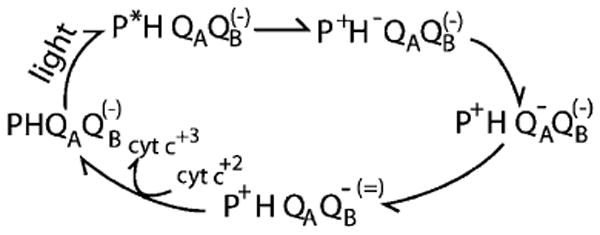Fig. 3.

The overview of the sequence of electron transfer reactions in the bacterial type II reaction centers. The reaction starts with a dimer of bacteriochlorophylls (P) excited by light. Electron transfer from the excited state (P*) leads to reduction of a nearby bacteriopheophytin (H). The reduced H•− is used to reduce the primary quinone, QA, which in turn reduces the secondary quinone, QB, to the anionic semiquinone (QB•−). Absorption of a second photon again leads to formation of QA•− which now reduces QB•− to the quinol, QH2, which dissociates from the protein and quinone is rebound. The QB charge in parenthesis is found on the second turnover. The order in which electrons and protons are added to QB is described in Fig. 4 B. In the membrane of the purple non-sulfur photosynthetic bacteria the cytochrome c is rereduced and the QH2 reoxidized by the cytochrome bc1 oxidoreductase with the concomitant increase in the transmembrane proton gradient
